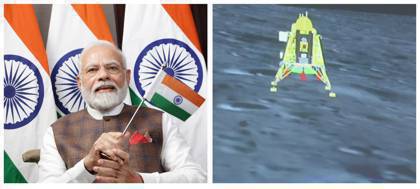

 EM News
EM News

India arrived at moon. The Chandrayan 3 of India landed on moon . The landing took place at 5:34am PT (6:04pm IST) on Wednesday over a month after the spacecraft’s launch, has made India the fourth nation globally to make a soft landing on the moon, after the former Soviet Union, the U.S. and China.
India’s space agency has released the first images of the Moon taken by the Chandrayaan-3 spacecraft, which entered lunar orbit on Saturday. The images show craters on lunar surface getting larger and larger as the spacecraft draws closer.
India is the first country to perform a controlled “soft landing” near the south pole. It has also become only the fourth to achieve a soft landing on the Moon after the US, the former Soviet Union and China.
India has become the first country to land one the lunar South pole.
After Chandrayaan-3’s successful landing, the plan for it is to deploy a rover on the Moon and explore the lunar south pole. The rover will imprint Indian flag and ISRO logo on the lunar regolith (soil) as it rolls.
On the Lander, it was reported that that the instruments in operation include CHASTE (Chandra’s Surface Thermo-Physical Experiment) to carry out the measurements of thermal properties of the lunar surface near the polar region, LRA (Laser Retroreflector Array), RAMBHA-LP- a Langmuir Probe to measure surface plasma density, a laser reflector mounted on the corner of the Vikram for accurate positioning measurement of Lander on the Lunar surface by future orbiters, ILSA - Instrument for Lunar Seismic Activity to measure seismicity around the landing site and to understand the structure of the lunar crust and mantle, LIBS- Laser Induced Breakdown Spectroscopy to determine the elemental composition (Mg, Al, Si, K, Ca,Ti, Fe) of Lunar soil and rocks around the lunar landing site, APXS - Alpha Particle X-Ray Spectrometer to measure the chemical composition and mineralogical composition to further enhance our understanding of Lunar-surface and SHAPE - Spectro-polarimetry of HAbitable Planet Earth to study the spectro-polarimetric signatures of the habitable planet Earth in the near-infrared (NIR) wavelength range (1 – 1.7 μm).